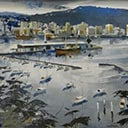Tourists Visiting the Pink Terraces of Rotomahana
72 x 102 cm
est. $80,000 - 120,000
O-tū-kapua-rangi - fountain of the clouded sky - The Pink Terrace.
Charles Blomfield has long been recognised as the most popular early New Zealand painter of the Pink and White Terraces. Both these paintings are exceedingly fine works and pre-date the Tarawera eruption. Blomfiled first saw the Terraces during a camping trip in December 1875, and commented that they were exceedingly beautiful and graceful. Returning in 1885 he spent six weeks documenting the Terraces and surrounding landscape in a series of oil paintings. It was reported that by September 1885 orders for paintings had been received and completed from throughout Europe, America, Australia and other places. Early on the morning of 10 June 1886, Mount Tarawera erupted, burying the terraces. Blomfield was heartbroken and decided to see the devastation for himself. He returned to the area in October and painted several scenes of the terrible destruction. A world away, fourteen of his Rotomahana paintings were on display in South Kensington, London at the Colonial and Indian Exhibition. This major exhibition strengthening the bonds of the the British Empire was opened by Queen Victoria and received 5.5 million visitors.
Blomfield realised that the paintings he had made of the Terraces were a valuable record, and declined to sell them. He went on to paint and sell scale copies of these works. The prices soon trebled in value.
After 1886 Blomfield continued to travel throughout New Zealand painting pictures of mountains, rivers, lakes and cloud effects, but his greatest love remained the native bush, of which he wrote enthusiastically in his diary. Charles Blomfield died in Auckland in 1926.
The Terraces were thought to be buried by the Tarawera eruption of June 1886. Separated by nearly a kilometre, the Pink Terraces were about two thirds of the way down the lake, sheltered from the harsh sun on the western shores, facing south-east. Their pink appearance was largely due to less exposure to sunlight, and therefore less bleaching. Tourists and locals bathed in the luke warm water on the lower level of the Pink Terraces.
In February 2011, a team including researchers from GNS Science, Woods Hole Oceanographic Institution, Lamont-Doherty Earth Observatory, and Waikato University were mapping the lake floor when they reported discovering part of the Pink Terraces. The lowest two tiers of the terraces were reported found at 60 metres. A part of the White Terraces was also reported as rediscovered in June 2011.
Researchers now believe they have found the terraces burial site and are calling for a full scale archaeological investigation.
Using reverse engineering and surveying works of 19th century geologist Dr Ferdinand von Hochstetter, researchers Rex Bunn and Dr Sascha Nolden deduced the Pink and White Terraces may have survived the 1886 Tarawera eruption.
Their paper, published June 2017 in the Journal of New Zealand Studies, plotted the three terrace locations beneath land, and not under Lake Rotomahana as imagined by 19th century colonists and accepted by some by some later researchers. These research and findings continue.





